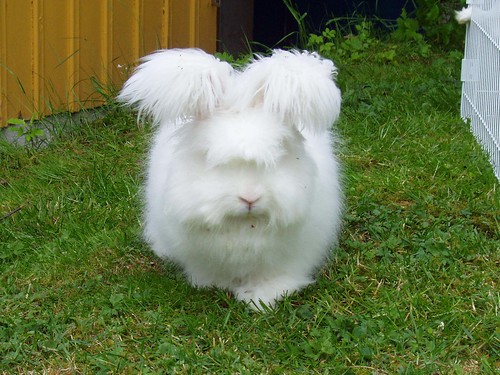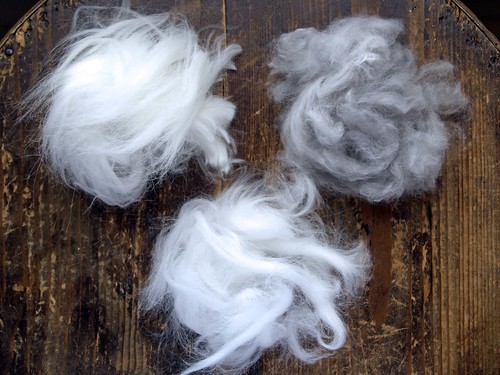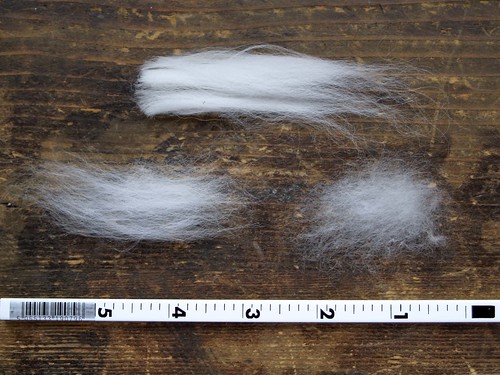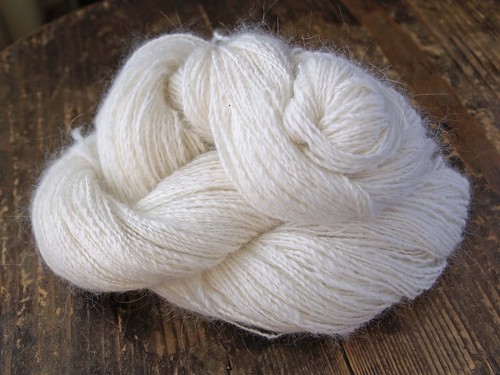Part 2: Angora
Angora Rabbits, like the goats of the same name, originated in Turkey near Ankara, the city for which they are named. They are large and docile and extremely popular as pets, as well as being the source of a luxurious silky fibre. It is said that they were a favourite of French royalty in the 18th century, and frankly, who wouldn’t want one of these funny-faced fluff-balls around?
Harvesting
Depending on the breed, Angora hair can be either shorn or plucked, usually four times per year. During this time the coat of some breeds can grow up to 4 inches in length. Naturally shedding fur is gently combed or plucked from the coat, leaving behind any longer guard hairs which may be present. Some breeds, including the German angora, need to be shorn, and this also occurs four times per year. Angora fur is very clean and doesn’t usually need any other preparation before spinning, in fact, it is very common at fibre festivals to see a spinner with a bunny on her lap – spinning straight from handfuls of the coat (pluckable only I hope!).
Fibre Characteristics
Angora is soft, smooth and silky, and depending on the breed, can vary in length from around 1 – 4 inches. It is very light and fine, usually around 13-15 microns, and is quite inelastic. Much of the finest Angora is very short and slippery and it is often blended with other fibres to make it easier to spin. Angora is also incredibly warm, eight times warmer than wool, meaning that even a small amount will add a lovely warmth and halo to a blended yarn. Use a larger size needle than usual for knitted garments to allow space for the halo to develop.
Varieties
There are many breeds of Angora rabbits. The American Rabbit Breeders’ Association recognises four main ones: English, French, Giant and Satin, which also have many varieties within the breed, each with differing characteristics. The English and French breeds are very common. Also very popular, but with its own association is the German Angora, like Billy pictured above. German Angora is generally not quite as fine as the French or English, and is shorn rather than plucked. There is also an Asian breed, which accounts for a growing commercial industry in Nepal and surrounding regions.
The three samples above are (clockwise) clipped German Angora, sent to me by Billy’s owner, Heidi Kim; plucked grey Angora, I picked this up in Australia and don’t know the origin, but it is quite different to the other two; plucked English angora, from a local fibre retailer.
When looking at the individual locks, it is easy to see the remarkable differences between each one (top: German; left: English; right: grey).
Heidi also sent me this gorgeous skein of handspun Angora yarn, pop over to her blog for more pics of her bunnies and say hello from me!
Do you have questions? What are your experiences with Angora – like it? Love it? Leave a comment or come by the Lingr chatroom on Sunday evenings.
Sources/further reading
Albright, Barbara. “The Natural Knitter�? Potter Craft 2007
Field, Anne. “The Ashford Book of Spinning�? Shoal Bay Press, revised 1999
Wikipedia.org “Angora Rabbit�?
http://www.arba.net/ American Rabbit Breeders’ Association
http://www.himalayan-healthcare.org/
http://hifeed.org/angora_2.html





 Entries (RSS)
Entries (RSS)
February 15th, 2009 at 12:52 pm
I haven’t got around to actually spinning any angora yet….but as you know, I’m dyeing an angora blend….why oh why is it so hard to get wet!? ;-) I can’t wait to start spinning some!
February 15th, 2009 at 4:52 pm
That angora yarn looks divine! I have an urge to pick it up and press it to my cheek…
February 15th, 2009 at 11:16 pm
I’m sad to say I’m terribly allergic to it! I get near Angora and have terrible asthma attacks. This is an important thing for social spinners to know…a few fibers (like rabbit fur) can cause terrible allergies because folks are allergic to the salivia or dander of the animal. Although I can go to a guild meeting and sit a distance away from someone spinning cleaned angora in a blend, it is very hard for me to breathe if there’s a rabbit in the room or someone’s just spinning from unwashed locks. This would never have occurred to me if I hadn’t learned it from going to guild meetings. That’s how I found out I’m allergic. Sad, but true, it’s the one fiber I do not knit, spin, or wear..aside from cat hair, which is unusual but also a real problem for some folks with asthma/allergies.
November 3rd, 2009 at 4:49 am
I have english angora blue color.